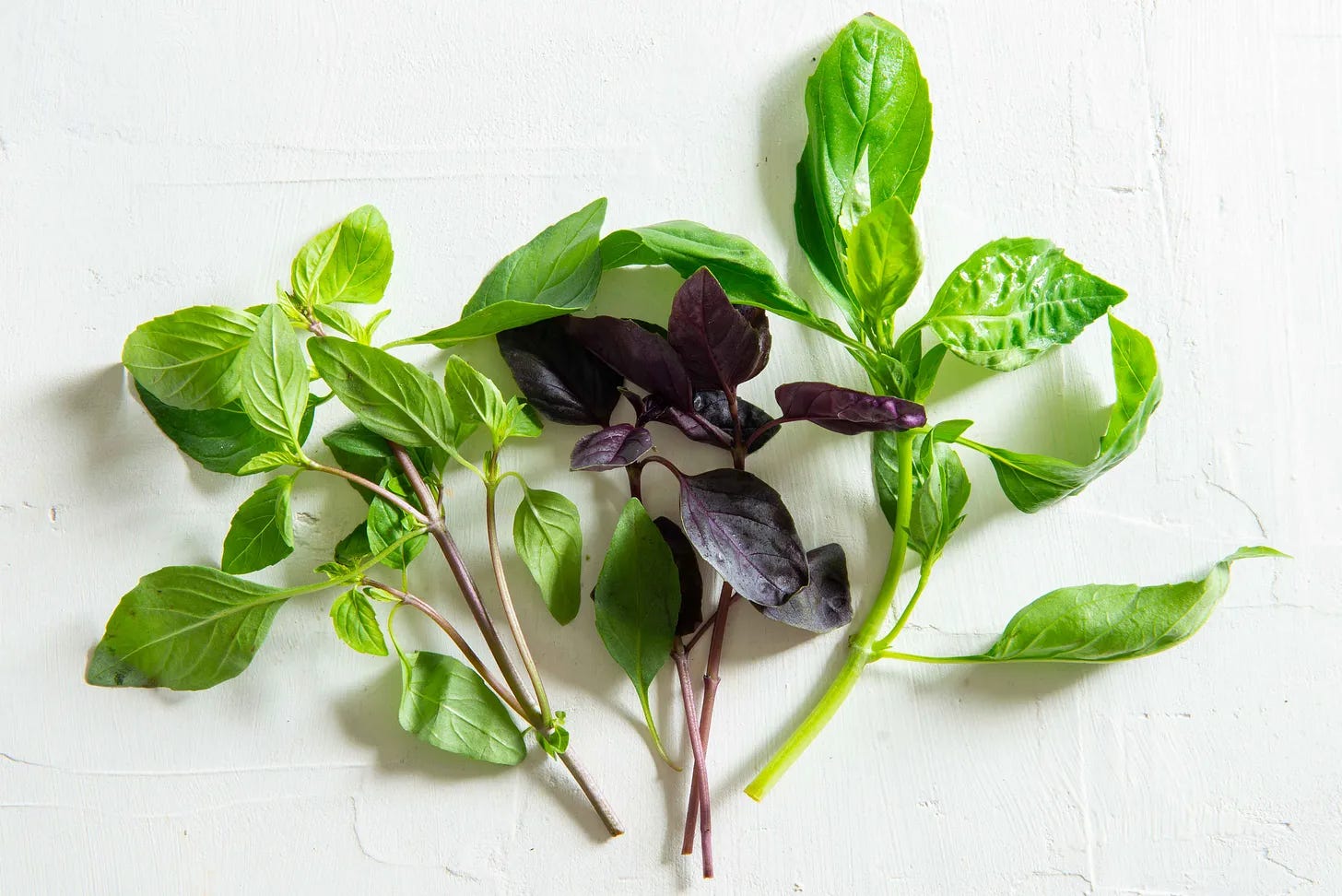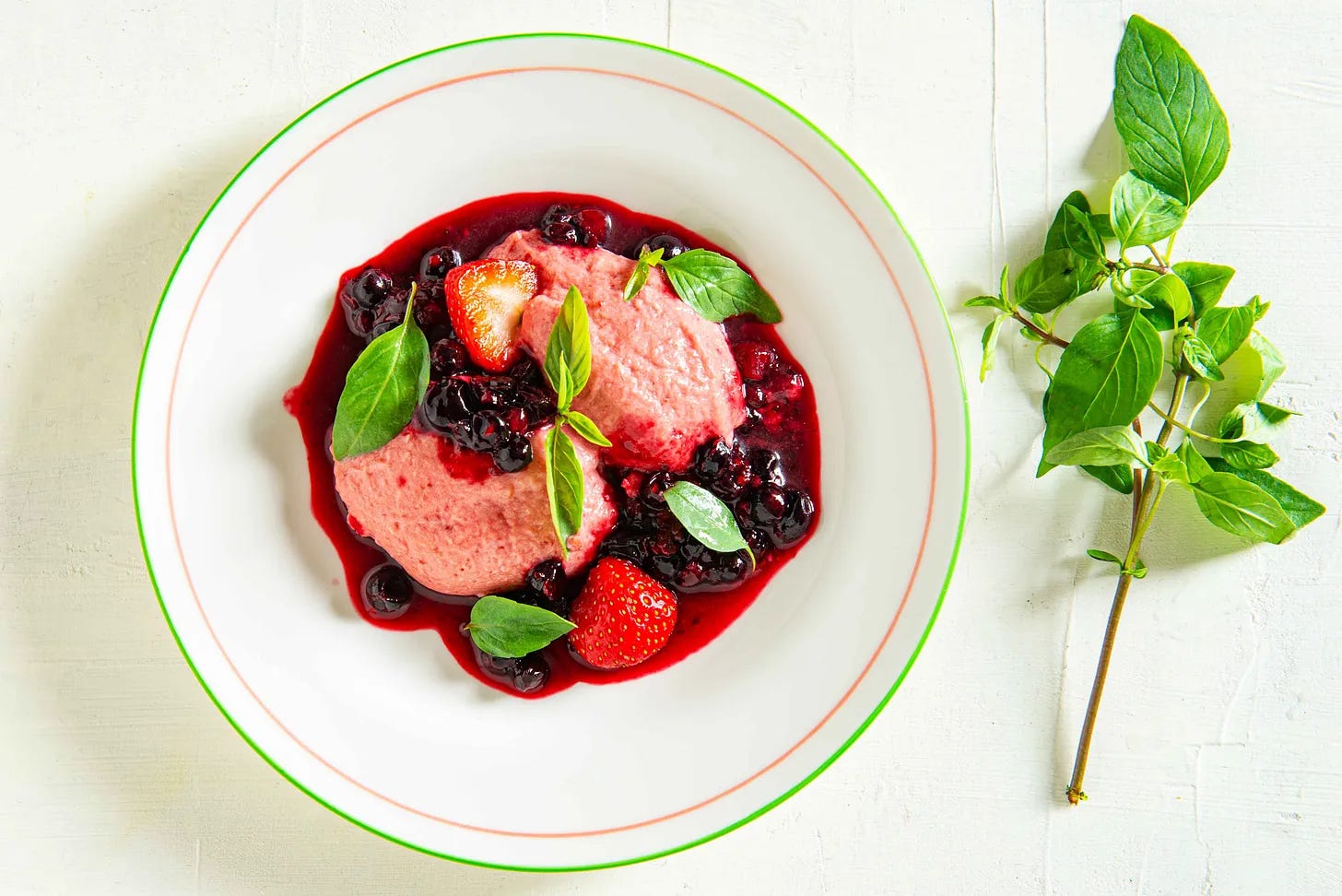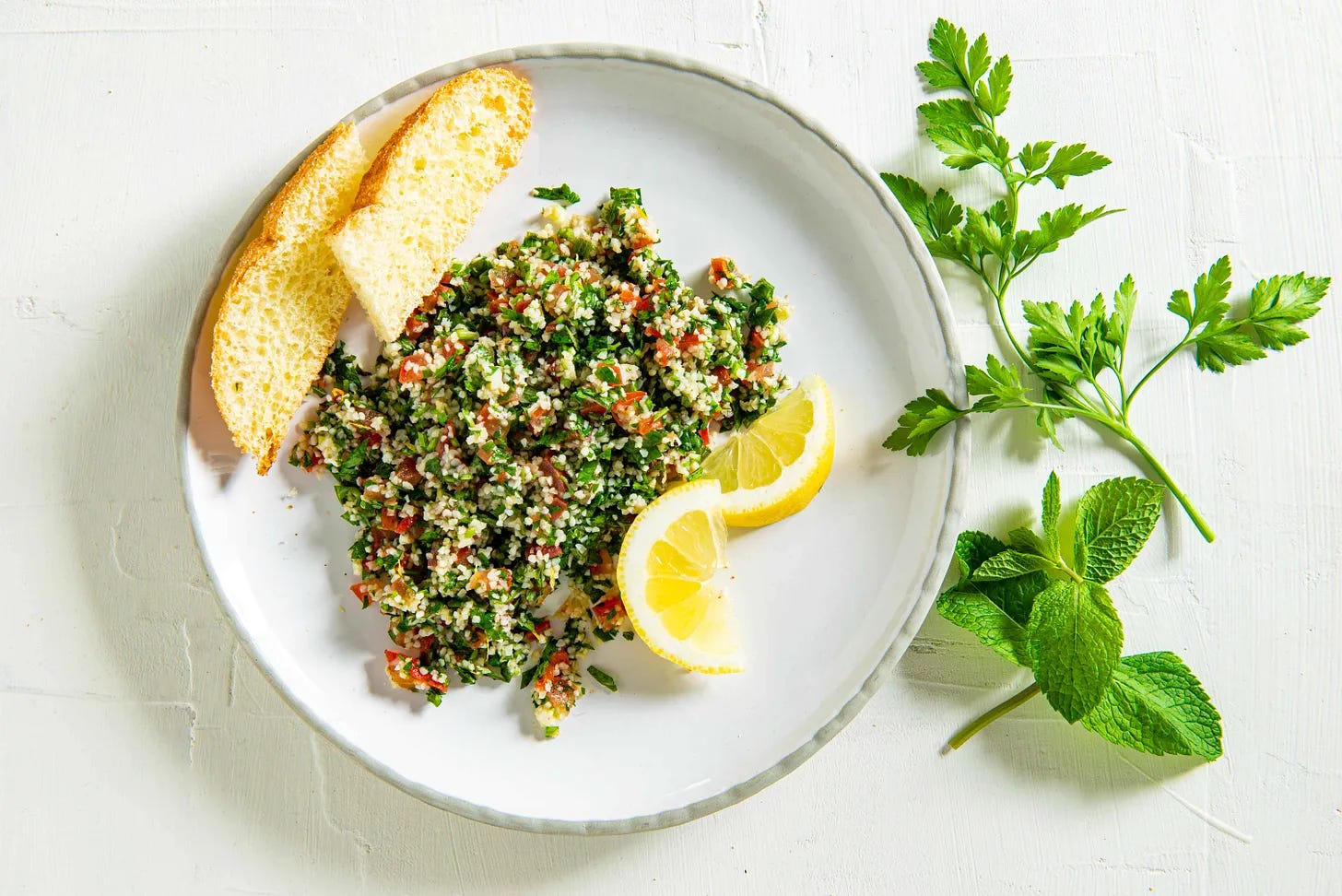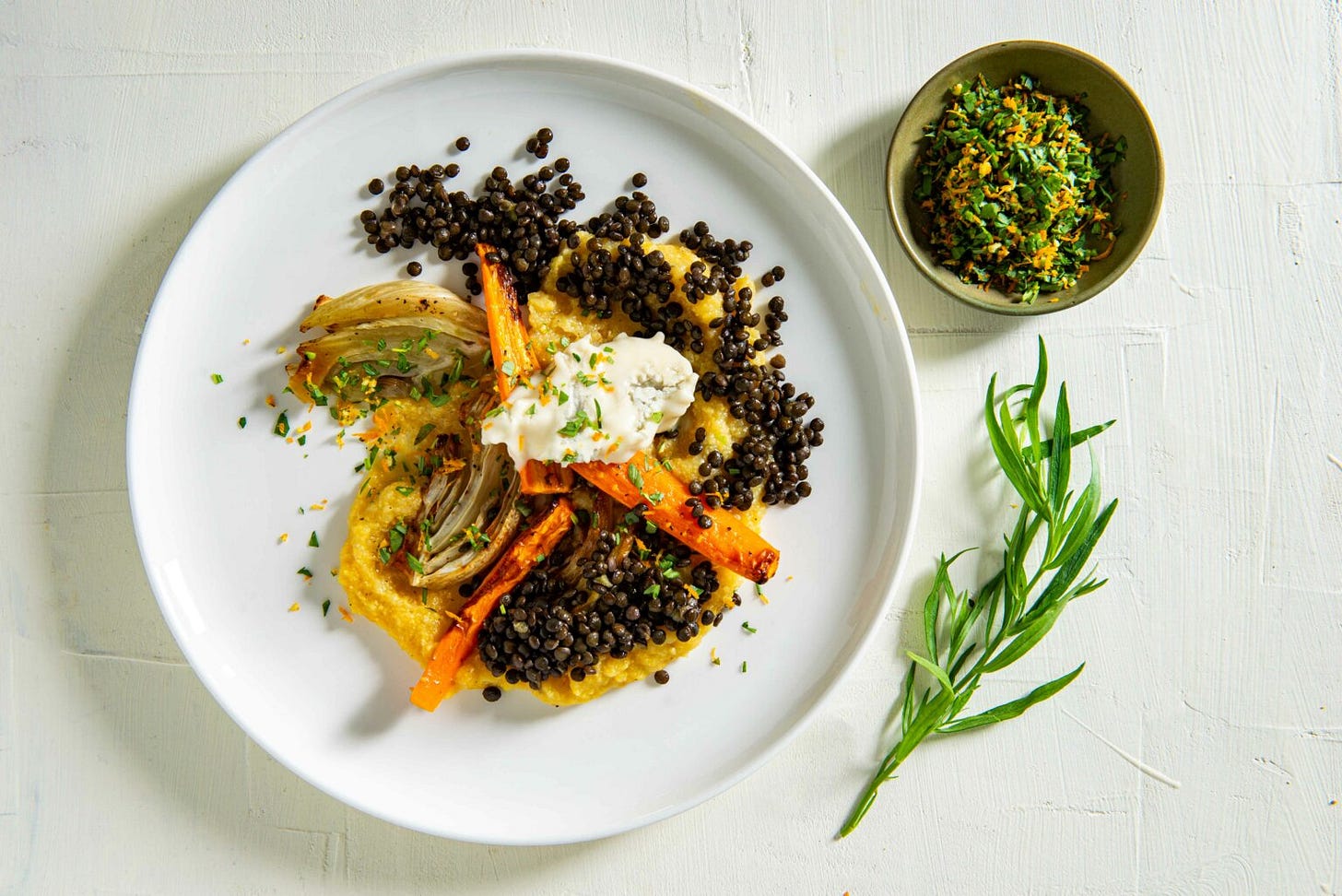Everyone knows: herbs make your food taste better. They add flavour, create delicious aromas, and they’re also healthy. In this newsletter, we answer lots of questions. Does it matter whether you use fresh or dried herbs? What’s the best moment to add herbs to your dish? How do you best capture and preserve their flavour? And in our herb guide, you’ll see at a glance which herbs go well with which dish. Of course, we’re also giving you some wonderfully herby recipes to get started yourself.
What are herbs?
From a botanical point of view, herbs are plants whose green, non-woody parts—like leaves, stems, and flowers—are used. Herbs can be annual or perennial, and some, like rosemary and thyme, may develop woody stems over time. In the kitchen, the green, leafy parts of plants are used to add aroma and flavour to dishes. Spices, by contrast, come from other aromatic, flavourful parts of plants such as roots, bark, seeds, fruits, and flower buds. Many of the compounds found in herbs (and spices) also have medicinal properties: most of the herbs we use in cooking have been part of traditional medicine for centuries. The wide variety of herbs you now find in supermarkets is a relatively recent development. In the 1980s, celery leaves and parsley were pretty much the only fresh herbs you could easily buy. Thankfully, that’s changed.
Herbs in the supermarket
At the start of this century, a herb revolution took place in supermarkets—driven in part by the popular books and cooking shows of Jamie Oliver. He casually demonstrated how fresh herbs could easily add depth of flavour to dishes. Nothing new, of course, for Southern European countries, but a welcome shift in Northern European kitchens. Over the past twenty years, the variety of herbs available in supermarkets has grown enormously. Still, many herbs can only be found at specialty stores or grown yourself. And in the wild, there are hundreds of edible herbs that can enrich your cooking.
Readily available in supermarkets
Soft herbs: basil, coriander, mint, dill, chives, celery leaves, flat-leaf and curly parsley
Sturdy herbs: thyme, rosemary, oregano, and sage
Less readily available
Soft herbs: tarragon, lemon balm, lemon thyme, lovage, chervil, sorrel, marjoram (related to oregano), Thai and purple basil
Sturdy herbs: savoury
Of course, there are many more herbs. In Asian grocery stores and professional food wholesalers, for example, you can find the aromatic, slightly minty shiso and various types of basil.
Texture: soft and hard leaves
You can categorize fresh herbs based on the texture of their leaves. Herbs with soft leaves, like basil and coriander, are delicate, meaning their volatile aromas are easily released when the leaves are cut. These aromas are also sensitive to heat, so it's best to add soft herbs at the end of cooking. Herbs with tougher leaves, such as thyme and rosemary, should be added at the beginning of a dish. The aromas in these sturdy leaves (or needles) need more time to be released and to blend into the food.
Smell & flavour
The taste and aroma of herbs are determined by their chemical composition, primarily the presence of volatile oils and other aromatic compounds. These substances are often concentrated in the leaves, flowers, seeds, or roots of the plant. They are released as soon as you chop, slice, or grind the herbs.
Volatile oils are complex mixtures of terpenes, phenols, esters, and other compounds that easily evaporate at room temperature. You perceive them through your sense of smell. The sharp scent of basil, for example, comes from eugenol, linalool, and methylchavicol.
Polyphenols: these compounds contribute to flavour and often have antioxidant properties. They are less volatile than the oils and are detected by the taste buds on your tongue and the nerve receptors in your mouth. Polyphenols are often associated with the bitter or astringent flavours in herbs.
Glucosinolates and alkaloids are other chemical compounds that can strongly influence flavour. They are perceived by the nerve receptors in your mouth. The spiciness of chili peppers, for example, comes from capsaicin, an alkaloid. Spiciness is therefore not technically a taste, but a mild pain sensation.
Chopping, slicing, or pounding?
As soon as you damage the cells of herbs, the volatile flavour compounds start to escape. The more cells you break, the more compounds are released. That’s why a mortar and pestle is an effective tool to extract flavour from herbs. But during pounding, a lot of those aromas evaporate—just smell it when you're making pesto. A few drops of oil can work wonders here, as they absorb the aromas (explained later in this newsletter).
A food processor also works well for chopping large amounts of herbs. Even then, it helps to add a few drops of oil. If you're chopping or slicing herbs, do it right before adding them to your dish. The longer they sit, the more aroma is lost—especially with soft herbs. On top of that, cut herbs start to discolor due to enzymatic reactions. Mint and basil, in particular, turn black quickly. Not only does this affect the flavor, but it also makes them look unappetizing.
Fresh versus dried herbs
Every fresh herb has a dried, finely chopped version that keeps for a long time (and takes up less space in your kitchen). So why use fresh herbs? First of all: for the flavour. Fresh herbs have a bright, fresh taste and a stronger, more aromatic scent than dried herbs. The flavour of dried herbs changes during the drying process due to the loss of essential oils, oxidation, and enzymatic reactions. The texture of dried herbs is also much tougher, while fresh herbs are juicy and soft.
Dried and delicious
So are dried herbs useless? Absolutely not. For sturdier herbs – oregano, marjoram (a variety of oregano), thyme, rosemary, sage and bay leaf – the dried version is often a good alternative to fresh. In fact, dried bay leaf is just as effective, if not more so, than fresh when it comes to infusing flavour into soups and stews. Some dishes even rely on dried herbs to deliver their signature flavour. The spice mix za’atar, made with dried thyme, oregano and sumac (a dried, ground tart berry), is a good example. Dried oregano is also essential in an Italian tomato sauce or a Mexican chilli. Provençal herbs, Italian herb mixes and ‘fines herbes’ are further examples of dried herb blends that have a distinct flavour you can’t replicate with fresh herbs.
Because dried herbs need time to rehydrate and release their flavour, you add them – unlike soft, fresh herbs – early in the cooking process. As a general rule of thumb, use about one third the amount of dried herbs in place of fresh. So, if a recipe calls for 15 grams of fresh mint, you would use around 5 grams of dried mint instead.
Storing herbs
Fresh herbs are best stored in the vegetable drawer of the fridge, wrapped in damp kitchen paper. Not enough fridge space? Then place the herbs in a glass of water, stems down, and loosely cover the top with a small plastic bag. This works especially well for basil, coriander, and parsley.
You can also finely chop fresh herbs and freeze them in portions. Mix them with a little oil and/or water and place them in an ice cube tray. This makes it easy to add them to soups, sauces, and stews, or use them in a dressing or pesto. Once frozen, herbs are no longer suitable for using fresh in salads or as a garnish.
You can store dried soft herbs for up to one year in the jars they come in. Keep them in a dark, dry place. After a year, much of their aroma will have dissipated. Dried robust herbs like thyme, rosemary, and oregano can be kept for up to two years before most of their flavour fades.
You can also dry fresh herbs in the oven at around 50 °C. Keep the oven door slightly open to allow moisture to escape. Air-drying is another option. It's best to dry herbs indoors in a well-ventilated spot rather than in direct sunlight. Once dried, chop or grind the herbs and store them in airtight jars.
Herb plants
Herb plants on your windowsill are convenient, but keeping them alive can be a challenge. They need proper care, enough water, light, and a bit of love. Sunlight is essential for basil, but most herb plants should be protected from the full afternoon sun. The same applies to herbs in your garden, although “wild” herbs are generally more robust than mass-produced greenhouse herbs. It helps to repot store-bought herbs right away into a larger pot with fresh potting soil. This gives the roots more space to grow and improves drainage.
Fat: the ideal carrier of aromas
As mentioned earlier, herbs contain essential oils. Since these aromatic compounds share physical properties with regular oil and fat, they dissolve well in them. This makes oil and fat ideal carriers for the flavour compounds in herbs. It’s no coincidence that there are so many types of herb oils. The process of capturing the flavours of herbs in oil or butter is called extraction—an interesting technique that can be very rewarding. In the recipe below, we explain exactly how to do it.
Making your own herb oil
For example, to make basil oil: gently fry 30 g of fresh basil leaves in 50 ml of neutral oil (about 4 tbsp) over medium heat until the leaves turn dark green—this takes about 1 minute. Grape seed oil is ideal, but a mild olive oil also works. Extra virgin olive oil is not recommended, as its strong flavour overpowers the herb aromas.
Transfer the fried basil leaves and oil to a food processor and blend together with another 100 ml of oil. Let the oil infuse overnight in the fridge, then bring it to room temperature and strain it through a fine sieve.
The ratio of 30 g per 150 ml oil (20%) applies to softer herbs such as coriander, parsley, and chervil. For oilier herbs like thyme, rosemary, sage, and oregano, 15 g per 150 ml oil (10%) is sufficient. Heating the herbs is important for both shelf life and colour retention—the green hue remains vibrant after heating.
Fresh herb oils should never be kept longer than three days in a tightly sealed bottle or jar. This way, you preserve the aromas and prevent spoilage. To store the oil for longer, freeze it in small portions (e.g., in an ice cube tray or freezer bag).
To make long-lasting herb oil, use dried herbs. Use about 1 tablespoon of dried herbs per 250 ml of neutral oil (such as sunflower, grapeseed or mild olive oil). Gently heat the dried herbs in the oil for about 10 minutes over low heat, keeping the oil temperature around 60 °C. Allow the oil to cool completely, then strain out the herbs using a fine sieve or cheesecloth. Store the herb oil in an airtight bottle or jar in a cool, dark place. It will keep for up to 6 months, though for the best flavour it's advisable to use it within 2 to 3 months.
Use herb oil to finish dishes. Basil oil is delicious drizzled over a salad or stirred into soup. Sage or oregano oil works beautifully in pasta dishes. Coriander oil is great on stir-fries or in tortillas. You can also combine different herb oils to add extra colour and flavour to a starter.
Sous-vide
You can also infuse the aromas of herbs and spices into oil using the sous-vide method. The big advantage of this technique is that the aromas can’t escape into the air. Use the same herb or spice-to-oil ratios as described above. Place everything in a vacuum bag and seal. Heat the herbs sous-vide for about 1 hour at 80°C. Strain and let cool.
Extracting into cream
Whipping cream contains between 30 and 40% butterfat, making it very suitable for absorbing aromas from herbs. Not only does it extract the oil-soluble flavours into the cream, but the water-soluble aromas are also retained (although they evaporate quickly). In the recipe for the strawberry mousse with Thai basil below, we first let the basil infuse in warm cream for a while. To release more aromas, it helps to bruise the leaves in the cream using a pestle or the back of a wooden spoon. After straining and cooling the cream, you can whip it until soft peaks and use it in a dessert.
Strawberry Mousse with (Thai) Basil
Servings: 4–6
Prep time: 30 min
Waiting time: 5 hours
INGREDIENTS
60 g Thai basil*
250 ml double cream
250 g strawberries (frozen)
½ lemon
175 g extra jam sugar**
1 tsp vanilla extract
250 g mixed red berries (frozen)
*You can substitute Thai basil with regular basil. Mint, lemon balm, tarragon, thyme or rosemary also pair well with strawberries. For woody herbs like thyme or rosemary, use only half the amount (25 g).
**For this recipe, ‘extra jam sugar’ is essential. It contains more pectin than regular jam sugar, which means you can use less to achieve the same set. Regular jam sugar requires a 1:1 ratio of sugar to fruit, which would make the dessert far too sweet.
METHOD
1. Gently heat 50 g of Thai basil (stems and leaves) with the cream over low heat for about 10 minutes. Do not let the cream exceed 40 °C, or it won’t whip properly. Try to bruise the leaves with a wooden spoon or pestle. Strain through a fine sieve, pressing out as much infused cream as possible. Let cool for 15 minutes, then chill in the fridge for at least 3 hours until it reaches 4–6 °C (fridge temperature).
2. Heat the frozen strawberries with a few tablespoons of water in a pan with the lid on. Let them defrost gently on low heat for 5 minutes. Meanwhile, zest and juice the lemon. Add both zest and juice to the pan along with 125 g of the jam sugar and blend the mixture using a stick blender. Bring to a boil and boil hard for 1 minute. (Longer boiling reduces the gelling effect of the sugar.)
3. Stir in the vanilla extract and let the strawberry sauce cool to room temperature (about 20 °C, approx. 2 hours), stirring occasionally to prevent a skin from forming.
4. Whip the infused cream until firm and fold in the cooled strawberry sauce. Chill the mousse in the fridge for a few hours until set.
5. Meanwhile, make the red fruit sauce. Heat the frozen berries with a couple of tablespoons of water for a couple of minutes until defrosted. Add the remaining jam sugar, bring to a boil and cook for 1 minute. Transfer to a bowl and let cool.
6. Use a warm spoon to scoop quenelles of the mousse and plate. Spoon the red berry sauce around and garnish with Thai basil leaves.
Tabbouleh (bulgur salad with parsley)
Servings: 4
Preparation time: 30 min
Resting time: approx. 45 min
INGREDIENTS
50 g bulgur
2 vine tomatoes
1 lemon
1 tsp coriander seeds
50 g flat-leaf parsley
20 g fresh mint
4 tbsp extra virgin olive oil
METHOD
1. Combine the bulgur with a pinch of salt and pour over 100 ml of hot water. Leave to soak for 15 minutes.
2. Halve the tomatoes and scoop out the seed cavities – these won’t be used. Dice the flesh finely and sprinkle with ½ tsp salt. Let sit for 15 minutes.
3. Zest the lemon and squeeze out the juice.
4. Toast the coriander seeds in a dry frying pan until fragrant. Transfer to a mortar and crush.
5. Finely chop the parsley and mint, and mix immediately with the olive oil and half the lemon juice in a large bowl.
6. Drain the tomatoes in a sieve and stir the diced tomato, bulgur, and crushed coriander into the herb mixture. Season the parsley salad with pepper, salt, and more lemon juice to taste.
Tip: Serve the tabbouleh as a light lunch or a side dish with a Mediterranean meal.
Ratatouille
Servings: 4–6
Preparation time: 45 min
Cooking time: approx. 60 min
INGREDIENTS
2 red onions
4 garlic cloves
1 small carrot (approx. 100 g)
4 sprigs of thyme
2 sprigs of rosemary
6 sprigs of oregano
400 g tinned peeled tomatoes
4 tbsp olive oil
1 small tin of tomato purée
1 aubergine
1 green courgette
1 yellow courgette
2 beef tomatoes
Extra: round baking dish (approx. 26 cm), baking paper, aluminium foil
METHOD
1. Finely chop 1 onion and the garlic. Dice the carrot. Strip the leaves from the herb sprigs and chop roughly. Purée the peeled tomatoes with a stick blender or mash with a fork.
2. Heat the oil in a frying pan and sauté the onion and carrot for approx. 5 min over medium heat. Add the garlic and half of the herbs and cook for 1 min. Stir in the tomato purée and cook for another 30 seconds. Add the puréed tomatoes and bring to a gentle simmer while stirring. Let the sauce simmer for 10 min. Season with salt and pepper.
3. Meanwhile, slice the aubergine, courgettes, and beef tomatoes into thin slices (½ cm). Halve the second onion and slice into thin half rings.
4. Preheat the oven to 180 °C.
5. Spread half of the tomato sauce over the base of the baking dish. Arrange half the vegetable slices alternately in a circular pattern, overlapping them slightly. Sprinkle with some herbs, salt, and pepper. Spoon the remaining tomato sauce over the top. Add a second layer of vegetables and finish with the rest of the herbs, salt, and pepper. Cut a round of baking paper to fit the dish and place it on top of the vegetables. Cover with foil. Bake the ratatouille for approx. 60 min, removing the foil and baking paper after 45 min.
Tip: Serve with bread, roasted potatoes, or (pilaf) rice.
Gremolata
Parsley gremolata is the classic garnish for osso buco, but it’s a great addition to many other dishes too. Delicious over grilled or roasted vegetables, a summer salad, or with sautéed mushrooms. Here we make gremolata with tarragon. Its subtle aniseed flavour pairs perfectly with the roasted fennel we serve alongside creamy blue cheese polenta and lentils.
Preparation time: 5 min
INGREDIENTS
30 g flat-leaf parsley (or tarragon)
2 garlic cloves
1 lemon
pinch of chilli flakes (optional)
METHOD
Finely chop the parsley and garlic. Zest the lemon using a fine grater. Mix all the ingredients and add the chilli flakes and a pinch of salt. You can sprinkle the gremolata over dishes as it is. Want more of a sauce? Stir in 100–120 ml mild olive oil.
Herb Overview
To wrap up, here’s a list of the most common and (fairly) readily available fresh herbs. For each herb, we mention a few dishes where the herb plays a key role in delivering the dish’s characteristic, authentic flavour. That’s not to say the dish won’t taste good without the herb. But it will taste noticeably different.
Basil
Flavour: sweet, herbal, mildly peppery with a hint of anise
Essential in: pesto alla genovese, caprese salad, watermelon & feta salad, pistou, tomato soup, melanzane alla parmigiana
Also good in: strawberry salad, sorbet, cheese-based salads, ratatouille
Chives
Flavour: mild onion, fresh, slightly spicy
Essential in: French omelette, potato salad, dip for jacket potatoes, vichyssoise (potato-leek soup)
Also good in: devilled eggs, herbed cream cheese
Savory
Flavour: spicy, peppery, herbal
Essential with: fresh broad beans with hollandaise
Also good in: bean stews, sauces for bean-based dishes
Lemon balm
Flavour: fresh, lemony with a slightly sweet undertone
Good in: fruit salads, sorbets, green salads
Lemon thyme
Flavour: citrus aroma with mild thyme flavour
Good with: roasted vegetables, roast potatoes, quiche, herbed butter (with grilled corn), lemon pasta
Dill
Flavour: slightly sweet, anise-like, fresh and mild
Essential in: tzatziki, dill sauce, borscht, pickled gherkins
Also good in: potato salad, scrambled eggs, quinoa with vegetables and lemon
Tarragon
Flavour: slightly sweet, aniseed-like, mildly bitter
Essential in: béarnaise, tarragon vinaigrette, tarragon butter
Also good in: potato salad, cream cheese dip, fennel salad, cauliflower quiche, cauliflower soup, boiled asparagus
Chervil
Flavour: mildly sweet, slightly aniseed
Essential in: chervil soup
Also good in: omelette, salads, mash
Coriander
Flavour: citrusy, slightly peppery, fresh
Essential in: guacamole, Thai curry, Mexican salsa, chana masala
Also good in: tacos, burritos, chickpea salad, lentil salad, green smoothies
Lovage
Flavour: strong aromatic, celery-like, slightly bitter
Essential in: vegetable stock
Also good in: asparagus soup, pea soup
Mint
Flavour: fresh, cooling, slightly sweet
Essential in: mint tea, tabbouleh, raita
Also good in: quinoa salad, couscous salad, fruit salad, roasted carrots, risi e bisi (risotto with peas)
Oregano
Flavour: spicy, herbal, slightly bitter
Essential in: Greek salad, pizza sauce, chilli sin carne
Also good in: roast potatoes, ratatouille, bruschetta
Parsley (flat-leaf and curly)
There are two types: curly and flat-leaf. Curly parsley is losing popularity to its flat-leaf cousin, which has more flavour. The only dish where curly parsley really shines is as a traditional garnish for prawn croquettes (fried curly parsley). Since curly parsley is firmer than flat parsley, this variety is more suitable for frying. For all other uses, flat-leaf is the better option.
Flavour: slightly bitter, fresh, herbal
Essential in: tabbouleh, pasta puttanesca, chimichurri, gremolata
Also good in: pasta primavera, couscous salad, potato salad, falafel
Rosemary
Flavour: highly aromatic, woody, slightly bitter
Essential in: focaccia, roast potatoes, ratatouille, white bean soup
Also good in: pumpkin risotto, Mediterranean roast vegetables
Sage
Flavour: earthy, herbal, slightly bitter
Essential in: sage butter for pasta (pumpkin ravioli, gnocchi), butternut squash soup
Also good in: mashed potatoes, mushroom risotto, carrot-goat’s cheese quiche, mushroom cream pasta, stuffed tomatoes
Celery leaves
Flavour: mild, earthy, slightly peppery, aromatic
Essential in: pea soup, mirepoix, vegetarian stock, Waldorf salad
Also good in: potato salad, raw vegetable salads
Thai basil
Flavour: sweet, aniseed-like, slightly peppery
Essential in: pad krapow, pho, Thai curry
Also good in: stir-fries, mango salad, tom yam
Thyme
Flavour: earthy, herbal, mildly peppery
Essential in: French onion soup, boeuf bourguignon, ratatouille, vegetable stock
Also good in: cassoulet, pissaladière (French onion pizza), sautéed mushrooms
Sorrel
Flavour: sour, citrusy, refreshing
Essential in: sorrel soup, French sorrel sauce
Also good in: mashed potatoes, spinach tart, vegetable soup










